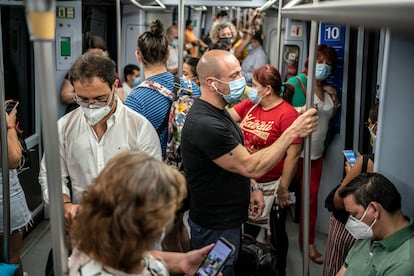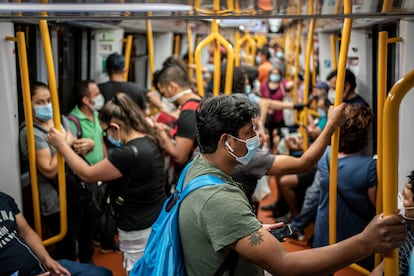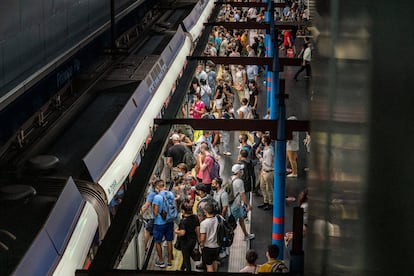Why you shouldn’t be afraid to take public transportation amid the Covid-19 pandemic
According to Spanish health experts, the risk of contagion on buses and trains is low thanks to safety measures like the use of face masks, as well as improved ventilation systems


The images of packed trains in the middle of the coronavirus pandemic have made many people in Spain afraid to take public transportation. During the state of alarm, this fear stemmed from the fact that little was known about the disease, and it was stoked by Spanish institutions, with Transportation Minister José Luis Ábalos claiming in April: “Cars are not a sustainable solution for the future, but in these circumstances they are an option.”
But studies in several countries have now shown that public transportation is not one of the main sources of contagion, and health experts also agree that with the new safety measures in place, such as face masks and disinfection, plus improved ventilation systems, there is not a high risk of infection – especially when compared to other activities, like eating in a closed space or going to a nighttime venue.
Indeed, Spain has not identified a single Covid-19 outbreak on its subway, train or bus systems. Despite this, the fear persists. According to a survey by the Spanish consumer protection group OCU, public transportation is considered by Spaniards as the most dangerous space (31% of respondents consider it very unsafe), ahead of sporting activities in closed spaces (28%) and cultural events (25%). Changing this perception is key to preventing cities from being overwhelmed by traffic when mobility returns to its normal levels.
“We have to think about why public transportation has been demonized, while other spaces where lots of people gather have gone unnoticed. This is where the battle for urban mobility comes into play, where the car industry is throwing a lot of weight against collective transportation. In every car advertisement, the word ‘safety’ is the central focus,” explains Padro Gullón, from the Spanish Epidemiological Association.
The fact that face masks became mandatory on public transportation three weeks before they were compulsory in other public spaces has also played a role in stigmatizing trains and buses.
“The use of cars is recovering much more quickly than public transportation. On a global level, the use of private cars in cities is between 70 and 80% of pre-pandemic levels, while on subways, trains and buses it is no higher than 50 to 60%,” explains David Lois, a researcher at the Transportation Research Center at the Polytechnic University of Madrid.
In Spain, collective city transit systems in cities lost 90% of their passengers in March and April due to the restrictions on movement, and they have still not recovered them. In Madrid, the Metro had 47% fewer passengers in July compared with last year; in Barcelona, passenger numbers on the Metro and bus network fell by 46% and 49% respectively; and in Valencia, Metro users declined by 46%. The Cercanías commuter train network has maintained just 50% of passenger numbers.
According to mobility data from Apple devices, searches relating to the use of cars rose more than 50% in the summer before later stabilizing, while searches for public transportation fell by 40% in the same period. Although these figures, which are published anonymously, only show data from Apple users, they show a trend that is similar in neighboring countries and cities.
What the studies say
Scientific studies are helping to show that these fears are unfounded. In Japan, researchers studied contagion hotspots in the country up until the end of May and found that most occurred in gyms, bars, concerts, karaoke clubs and restaurants – not on public transportation. In France, nearly 1,100 coronavirus outbreaks were identified between May and August and similar results were discovered: 27% were related to companies and the workplace, 14% to family gatherings and 12% to health centers. Only 1% (15 cases out of 1,100) were linked to buses, subways and trams. And in Switzerland, none of the 800 infection hotspots tracked in August were related to public transportation.
A recent study reviewed 2,300 infected passengers who traveled on trains in China between December and February, as the country was experiencing the peak of the pandemic. Of the 72,000 passengers who sat close to these cases, only 0.34%, or 234 people, contracted the disease. However, another study published last week looked at an outbreak on a bus in the Chinese province of Hubei at the end of January, where one third of the passengers (23 people) caught the coronavirus from one person. But the travelers in this case were not wearing face masks and the bus did not have a working ventilation system.

Although Spain does not provide data on the origin of contagions, neither the Health Ministry nor Spanish regions with large public transportation networks (Madrid, Catalonia and Valencia) have so far identified any coronavirus outbreak on a bus or train. Ildefonso Hernández, a professor of public health at Miguel Hernández University, says that “the studies that attribute part of the transmission to public transportation were situations at the beginning of the pandemic, when the measures were not as strict.”
In June, a team at Spain’s National Research Council (CSIC) led by Xavier Querol and Gloria Sánchez analyzed samples taken from handrails, stairs, turnstiles, vending machines, handles and air conditioning filters at Valencia’s Metro network and found no presence of coronavirus on the premises.
How coronavirus spreads
The main two sources of coronavirus contagion are microdroplets, which we emit when we speak, breathe or sneeze – hence the need for social distancing and face masks – and aerosols, minute particles of these respiratory droplets that remain suspended in the air. Xavier Querol, from CSIC, explains that his team did a modeling study in a closed space of 105 square meters, similar to a train carriage. “If the ventilation system continuously took 25% of air from the outside, the risk of infection from aerosols was 10 times lower. With respect to microdroplets, if everyone wears a mask the problem is solved,” says Querol.
“There are some buses that already ventilate 50% of air and take another 50% of outdoor air, and most Metro trains also have 30% outdoor air,” he adds. " With face masks, optimized ventilation, the disinfection that is done on all surfaces and hand sanitizer, I think the Metro is no less safe than a cafe, where people tend to talk without their masks."
Madrid’s Metro, for example, filters air between 24 and 44 times an hour, depending on the model of the carriage; the Barcelona Metro does it 13 times and wants to increase this to 24; and on the Cercanías commuter train network, air is filtered six times an hour. The constant opening of doors also helps renew the air.
The third way the coronavirus is spread is by fomites, or surfaces and objects that are contaminated by the virus, which we touch before bringing our hands to our eyes, nose and mouth. To avoid this, buses, train carriages and stations are disinfected at least once a day. On the Madrid Metro system, all surfaces that could come into contact with passengers are disinfected three times a day.
Safer than the bar?
So is public transportation safer than a bar? According to Pedro Guillón, from the Spanish Epidemiological Association, "we spend less time on the Metro or Cercanías network, around 30 to 40 minutes, with new people at each stop. Most people don’t talk and everyone wears a face mask. And, with the exception of peak hour, there are not normally large crowds.
“In contrast, in nightclubs and bars, you have to scream to make yourself heard over the music, people take off their face masks, they drink alcohol, there are fewer safety measures and more time is spent there,” he explains, adding: “commuting is an essential activity, while nighttime venues are not.”
Ildefonso Hernández agrees: “Bars and nightclubs exist to provide social interactions, which encourages greater proximity between people [...] And when you drink alcohol it is more difficult for you to remember all the preventive measures. If there is an infected person at a bar and you spend several hours inside, with little ventilation, the risk of contagion will also increase.”

The health experts explains that “the time of the day when there are more people in the Metro is during short trips that go through the city center, while on long trips there are fewer people and less of a risk,” but adds there is no such thing as zero risk.
In order to further reduce the risk of contagion, Hernández recommends that hand sanitizer dispensers be installed in trains and stations, as passengers “cannot avoid touching lots of elements, for instance when holding on inside the carriage or the hand railing of the stairs.”
Hand sanitizer is available in Valencia’s Metro network, but not in Madrid, and the Barcelona Metro and the Cercanías line only offer it at the busiest stations.
According to Xavier Querol, it is also important to increase safety distances by increasing the frequency of trains and dividing peak hour in stages – a point that was repeated by Fernando Simón, the director of the Health Ministry’s Coordination Center for Health Alerts, on August 17. “The fact that masks are mandatory helps reduce the risk when there are crowds, but it would be better for there not to be any [crowds] at alll,” he said.
Few sectors are taking as many measures as public transportation, but despite this it continues to have a bad reputationÁlvaro Fernández Heredia, manager of city buses in Valladolid
But there is still a lot to be done on this issue. Madrid Metro authorities said that the same number of trains were circulating in August as last year, even though there were 40% fewer passengers, and promised that the frequency would increase 20% during peak hours in September. Despite this, images of packed platforms and trains were frequently shared on social media this summer. Unions claim that only 45 of the 300 new drivers promised one year ago have been hired. Meanwhile in Catalonia, the Barcelona Metropolitan Transit (TMB) authority says that bus and subway train frequency has been increased in peak hours, with greater frequency set for the coming months. In Valencia, Metro authorities say that frequency increased 22% in summer, while Cercanías will boost numbers by 15% in September. Madrid’s Metro has also launched a system to stop passengers from entering stations when these hit capacity, a measure that Valencia wants to introduce in September.
“Few sectors are taking as many measures as public transportation, but despite this it continues to have a bad reputation. We have to turn this image on its head,” says Álvaro Fernández Heredia, the manager of city buses in Valladolid.
“If we don’t do this, there will be more traffic jams and an increase in pollution in cities, which could increase the fatality rate of the coronavirus,” warns Marta Serrano, transportation consultant and founder of Women in Movement.
The Transportation Ministry is planning on launching a campaign in September to let people know that public transportation is safe. And similar measures have already been introduced in Barcelona and Valencia.
“We have to dedicate all our efforts to showing that public transportation is safe. If we don’t do this, air quality will worsen and this will have a very negative impact on the health of the population,” explains Querol.
English version by Melissa Kitson.
Tu suscripción se está usando en otro dispositivo
¿Quieres añadir otro usuario a tu suscripción?
Si continúas leyendo en este dispositivo, no se podrá leer en el otro.
FlechaTu suscripción se está usando en otro dispositivo y solo puedes acceder a EL PAÍS desde un dispositivo a la vez.
Si quieres compartir tu cuenta, cambia tu suscripción a la modalidad Premium, así podrás añadir otro usuario. Cada uno accederá con su propia cuenta de email, lo que os permitirá personalizar vuestra experiencia en EL PAÍS.
¿Tienes una suscripción de empresa? Accede aquí para contratar más cuentas.
En el caso de no saber quién está usando tu cuenta, te recomendamos cambiar tu contraseña aquí.
Si decides continuar compartiendo tu cuenta, este mensaje se mostrará en tu dispositivo y en el de la otra persona que está usando tu cuenta de forma indefinida, afectando a tu experiencia de lectura. Puedes consultar aquí los términos y condiciones de la suscripción digital.
More information
Últimas noticias
Most viewed
- Sinaloa Cartel war is taking its toll on Los Chapitos
- Oona Chaplin: ‘I told James Cameron that I was living in a treehouse and starting a permaculture project with a friend’
- Reinhard Genzel, Nobel laureate in physics: ‘One-minute videos will never give you the truth’
- Why the price of coffee has skyrocketed: from Brazilian plantations to specialty coffee houses
- Silver prices are going crazy: This is what’s fueling the rally









































